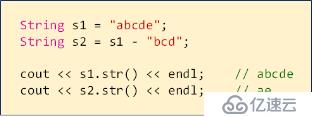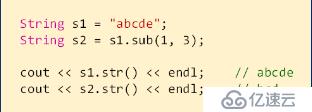您好,登錄后才能下訂單哦!
您好,登錄后才能下訂單哦!
我們在上節博客中講到了 KMP 算法的具體實現,那么我們本節就來看看 KMP 算法的應用。問題:如何在目標字符串中查找是否存在指定的子串?
我們來看看字符串類中的新功能,如下圖所示

1、子串查找(KMP 算法的直接應用)
int indexOf(const char* s) const;
int indexOf(const String& s) const;
我們來看看具體源碼的實現,如下
int String::indexOf(const char* s) const
{
return kmp(m_str, s ? s : "");
}
int String::indexOf(const String& s) const
{
return kmp(m_str, s.m_str);
}直接利用我們上節博客實現的 kmp 函數就能實現 indexOf 函數,我們來看看效果
#include <iostream>
#include <cstring>
#include "DTString.h"
using namespace std;
using namespace DTLib;
int main()
{
String s = "ababax";
cout << s.indexOf("bax") << endl;
return 0;
}編譯運行結果如下

我們看到返回的位置為下標為 3 處,也就是 s[3] 處。
2、在字符串中將指定的子串刪除
String& remove(int i, int len);
String& remove(const char* s);
String& remove(const String& s);
根據 KMP 在目標字符串中查找子串的位置,再通過子串位置和子串長度進行刪除。具體源碼實現如下
String& String::remove(int i, int len)
{
if( (0 <= i) && (i < m_length) )
{
int n = i;
int m = i + len;
while( (n < m) && (m < m_length) )
{
m_str[n++] = m_str[m++];
}
m_str[n] = '\0';
m_length = n;
}
return *this;
}
String& String::remove(const char* s)
{
return remove(indexOf(s), s ? strlen(s) : 0);
}
String& String::remove(const String& s)
{
return remove(indexOf(s), s.length());
}我們來寫個測試代碼進行測試,如下
#include <iostream>
#include <cstring>
#include "DTString.h"
using namespace std;
using namespace DTLib;
int main()
{
String s = "ababax";
cout << s.remove("bab").str() << endl;
return 0;
}我們來看看結果是不是 aax,如下

3、字符串的減法操作定義(operator -)
使用 remove 實現字符串間的減法操作,必須得保證字符串自身不被修改,返回產生的新串。最后效果如下

String operator - (const String& s) const;
String operator - (const char* s) const;
String& operator -= (const String& s);
String& operator -= (const char* s);
利用原有的 + 操作符進行改裝即可,源碼實現如下
String String::operator - (const String& s) const
{
return String(*this).remove(s);
}
String String::operator - (const char* s) const
{
return String(*this).remove(s);
}
String& String::operator -= (const String& s)
{
return remove(s);
}
String& String::operator -= (const char* s)
{
return remove(s);
}我們來測試下,測試代碼如下
#include <iostream>
#include <cstring>
#include "DTString.h"
using namespace std;
using namespace DTLib;
int main()
{
String s = "ababax";
String s1 = s - "bax";
cout << s.str() << endl;
cout << s1.str() << endl;
s -= s;
cout << "[" << s.str() << "]" << endl;
return 0;
}我們來看看運行結果,s1 = "aba", 最后的 s 應該為空,我們來看看結果

我們看到結果正如我們所分析的那樣。
4、字符串中的子串替換
String& replace(const char* t, const char* s);
String& replace(const String& t, const char* s);
String& replace(const char* t, const String& s);
String& replace(const String& t, const String& s);
我們來看看具體源碼的實現
String& String::replace(const char* t, const char* s)
{
int index = indexOf(t);
if( index > 0 )
{
remove(t);
insert(index, s);
}
return *this;
}
String& String::replace(const String& t, const char* s)
{
return replace(t.m_str, s);
}
String& String::replace(const char* t, const String& s)
{
return replace(t, s.m_str);
}
String& String::replace(const String& t, const String& s)
{
return replace(t.m_str, s.m_str);
}我們來寫個測試代碼進行測試,代碼如下
#include <iostream>
#include <cstring>
#include "DTString.h"
using namespace std;
using namespace DTLib;
int main()
{
String s = "ababax";
s.replace("baba", "xyz");
cout << s.str() << endl;
return 0;
}我們來看看最后的結果是不是 axyzx,運行結果如下

5、從字符串中創建子串
String sub(int i, int len) const;
以 i 為起點提取長度為 len 的子串,子串提取保證不會改變字符串本身的狀態。如下

具體源碼實現如下
String String::sub(int i, int len) const
{
String ret;
if( (0 <= i) && (i < m_length) )
{
if( len < 0 ) len = 0;
if( len > m_length ) len = m_length - i;
char* str = static_cast<char*>(malloc(len + 1));
strncpy(str, m_str + i, len);
str[len] = '\0';
ret = str;
}
else
{
THROW_EXCEPTION(IndexOutOfBoundsException, "Parameter i is invalid ...");
}
return ret;
}我們來寫個測試代碼進行測試,測試代碼如下
#include <iostream>
#include <cstring>
#include "DTString.h"
using namespace std;
using namespace DTLib;
int main()
{
String s = "ababax";
String s1 = s.sub(3, 10);
String s2 = s.sub(2, 3);
cout << s.str() << endl;
cout << s1.str() << endl;
cout << s2.str() << endl;
return 0;
}最后的結果應該是 s = "ababax" ; s1 = "bax" ; s3 = "aba" ; 運行結果如下

現在我們的字符串類已經實現的有點規模了。通過今天對字符串類的學習,總結如下:1、字符串類是工程開發中必不可少的組件;2、字符串中應該包含常用的字符串操作函數,a> 增:insert, operator + , ...; b> 刪:remove,operator -,...; c> 查:indexOf,...; d> 改:replace,... 。
免責聲明:本站發布的內容(圖片、視頻和文字)以原創、轉載和分享為主,文章觀點不代表本網站立場,如果涉及侵權請聯系站長郵箱:is@yisu.com進行舉報,并提供相關證據,一經查實,將立刻刪除涉嫌侵權內容。